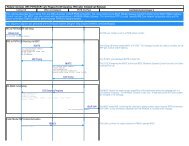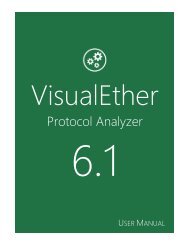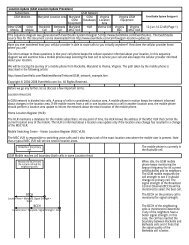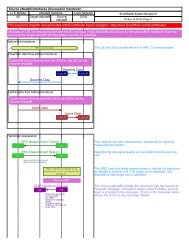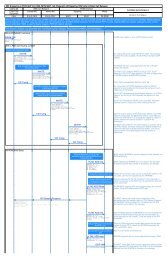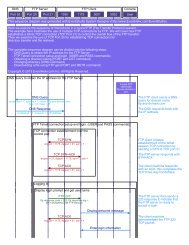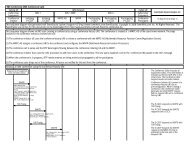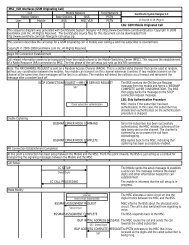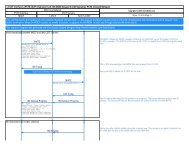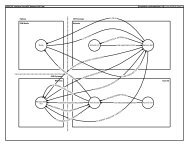Other ICMP Interactions - EventHelix.com
Other ICMP Interactions - EventHelix.com
Other ICMP Interactions - EventHelix.com
You also want an ePaper? Increase the reach of your titles
YUMPU automatically turns print PDFs into web optimized ePapers that Google loves.
<strong>ICMP</strong> - Internet Control Message Protocol (Trace Route)<br />
Client Internet Server<br />
User Client Node Router1 Node Router2 Node Server Node<br />
User Application Router1 Router2 Server Node<br />
<strong>EventHelix</strong>.<strong>com</strong>/EventStudio 1.0<br />
03-Feb-02 18:51 (Page 2)<br />
Copyright (c) 2002 <strong>EventHelix</strong>.<strong>com</strong> Inc. All Rights Reserved.<br />
LEG: Trace Route<br />
Trace Route utility relies on the <strong>ICMP</strong> Time Exceeded message to trace the route from the source to the destination. A UDP<br />
message with low time to live (TTL) value is used to trace the route from the source to destination. Client starts with a TTL<br />
value of 1, this results in the first router dropping the packet and responding with <strong>ICMP</strong> Time Exceeded. This identifies the<br />
router that rejected the message. Client then increases the TTL value incrementally until the <strong>com</strong>plete path has been identified.<br />
Trace_Route<br />
UDP_Datagram<br />
source = client, destin = server, ttl =<br />
one, destin_port = invalid<br />
Decrement Time To Live<br />
<strong>ICMP</strong>_Time_Exceeded<br />
source = router1, destin = client<br />
Display Path Information<br />
UDP_Datagram<br />
ttl = two<br />
Display Path Information<br />
Decrement Time To Live<br />
UDP_Datagram<br />
ttl = one<br />
<strong>ICMP</strong>_Time_Exceeded<br />
source = router2, destin = client<br />
Decrement Time To Live<br />
UDP_Datagram<br />
ttl = three, destin_port = invalid<br />
UDP_Datagram<br />
ttl = two, destin_port = invalid<br />
UDP_Datagram<br />
ttl = one, destin_port = invalid<br />
<strong>ICMP</strong>_Destination_Unreachable<br />
header_code = PORT_UNREACHABLE, source = server, destin = client<br />
Print out <strong>com</strong>plete route<br />
User issues the Trace Route <strong>com</strong>mand<br />
Trace Route then prepares a UDP datagram<br />
destined for the requested node. The time to<br />
live field is set to 1. This will ensure that the<br />
first node to receive this datagram will reject it.<br />
An invalid destination port number is used in<br />
detecting reached destination (more about this<br />
later)<br />
Router receives the UDP packet and<br />
decrements the time to live field from 1 to 0<br />
Since TTL has reached a value of 0, Router1<br />
drops the datagram and responds back to the<br />
sender of the message with <strong>ICMP</strong> Time<br />
Exceeded message.<br />
Display the information about Router1<br />
Trace Route then sends the UDP message<br />
again. Now time to live field is set to 2. This<br />
will ensure that the second node to receive this<br />
datagram will reject it.<br />
Router receives the UDP packet and<br />
decrements the time to live field from 2 to 1<br />
The UDP datagram is forwarded to the next<br />
node in the path<br />
Router receives the UDP packet and<br />
decrements the time to live field from 1 to 0<br />
Since TTL has reached a value of 0, Router2<br />
drops the datagram and responds back to the<br />
sender of the message with <strong>ICMP</strong> Time<br />
Exceeded message.<br />
Display the information about Router2<br />
Now a new UPD Datagram is sent with a TTL<br />
value of 3<br />
The message has been delivered to the<br />
destination node. IP layer passes the message to<br />
the UDP layer.<br />
UDP does not find the destination port. (Trace<br />
Route had used an invalid destination port to<br />
force this condition). <strong>ICMP</strong> then sends<br />
Destination Unreachable message to the source<br />
of the message<br />
Receipt of "Destination Unreachable" signals<br />
<strong>com</strong>pletion of route tracing from the source to<br />
the destination



